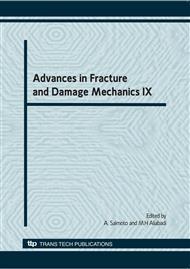p.149
p.153
p.157
p.161
p.165
p.169
p.173
p.177
p.181
Out-Plane Distortion Induced Fatigue Analysis of Steel Bridges
Abstract:
Induced forces in secondary steel bridge members such as diaphragms and cross-bracing can cause out-of-plane distortion in webs that may lead to fatigue cracking. Such cracking is most likely to occur if the distortion must be accommodated in a short length of the web, such as in the gap between the end of transverse stiffeners and girder flanges, because the web gap is subject to double curvature. In this paper, the numerical analysis model of a real 3-span continue steel bridge was established using ANSYS software to calculate the real fatigue stress at the web gaps. Some key structural parameters, for example, web gap depth and web thickness, have been considered in the numerical models. The results show that web thickness and web gap depth give the great affection on the out-of-plane distortion fatigue stress at web gaps.
Info:
Periodical:
Pages:
165-168
Citation:
Online since:
November 2010
Authors:
Price:
Сopyright:
© 2011 Trans Tech Publications Ltd. All Rights Reserved
Share:
Citation:


